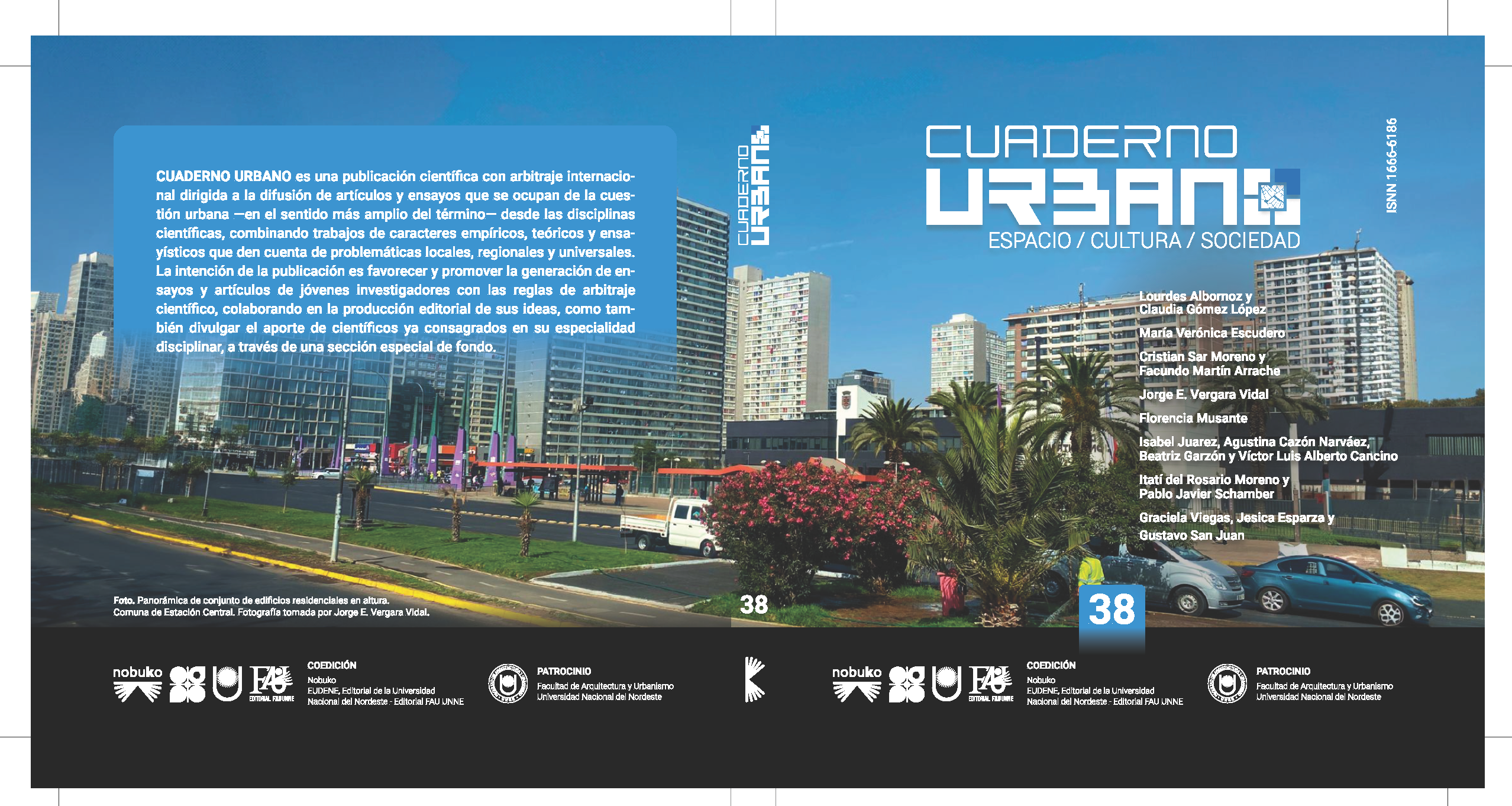Poéticas de la verticalización. Lo sublime y las altas edificaciones en las ciudades chilenas
DOI:
https://doi.org/10.30972/crn.38387677Palabras clave:
Verticalización, paisajes urbanos, sublime, poéticas técnicas, edificaciones en alturaResumen
Considerando los efectos estéticos que la intensiva construcción de edificaciones en altura tiene sobre los paisajes materiales de las ciudades chilenas, el presente texto explora la noción de sublime como un modo de caracterización de los modos de asombro y perplejidad que producen en quienes habitan estos entornos urbanos. Tras analizar un amplio conjunto de fotografías de edificios en a ltura tomadas durante investigaciones realizadas entre los años 2016 y 2023, el trabajo expone y discute un encuadramiento
que propone tres tipos de sublime que pueden ser útiles para caracterizar las poéticas del habitar que el fenómeno sociotécnico de la verticalización sugiere a quienes la observan. El texto concluye que las poéticas técnicas identificadas están organizadas en torno a escalas de vastedad que fundamentan su efecto estético.
Descargas
Citas
Baudrillard, J. y Nouvel, J. (2002). Los Objetos Singulares: Arquitectura y Filosofía. Fondo de Cultura Económica.
Benjamin, W. (2003). La obra de arte en la época de su reproductibilidad técnica. Editorial Itaca
Debord, G. (1995). La Sociedad del Espectáculo. Ediciones Naufragio.
Gandy, M. (2019). Foreword: What Is an Urban Landscape?. En, Bianca Maria Rinaldi y Puay Yok Tan (Eds.). Urban Landscapes in High-Density Cities. Parks, Streetscapes, Ecosystems. Birkhäuser (pp. 8–9). https://doi.org/10.1515/9783035617207-001
Gandy, M. y Steiner, H. (2019). “Enlarging the urban orchestra. Re-thinking current approaches to landscape architecture”. En, Ellen Braae, Henriette Steiner. Routledge Research Companion to Landscape Architecture. Routledge. https://doi.org/10.4324/9781315613116
Glaeser, E. (2018). El triunfo de las ciudades: Cómo nuestra mejor creación nos hace más ricos, más listos, más sostenibles, más sanos y más felices. Taurus.
Guber, R. (2011). La etnografía. Método, campo y reflexividad. Siglo XXI Editores.
Hertz, N. (1985). The Notion of Blockage in the Literature of the Sublime. En, The End of the Line. Essays on Psychoanalysis and the Sublime (pp. 40-59). Columbia University Press.
Hilberseimer, L. (2012). Metropolis architecture and Selected Essays. The Columbia University GSAPP BOOKS.
Holl, S. (2018). Cuestiones de percepción. Fenomenología de la arquitectura. Gustavo Gili.
Koolhaas, R. (2004). Delirio de Nueva York. Un manifiesto retroactivo para Manhattan. Gustavo Gili.
Koolhaas, R. (2014). Acerca de la ciudad. Gustavo Gili.
Loos, A. (2019). Ornament And Crime: Adolf Loos. New York: Penguin Books.
Nye, D. (1994). American Technological Sublime. The MIT Press.
Nye, D. (2018). American Illuminations Urban Lighting, 1800–1920. The MIT Press.
Nye, D. (2021). Conflicted American Landscapes. The MIT Press.
Orellana, A., Vicuña, M., Link, F., Perrozzi, A., Marshall, C., Truffello, R., & Señoret, A. (2022). Verticalización y configuración socioespacial de Santiago. AUS [Arquitectura / Urbanismo / Sustentabilidad], (31), pp. 31–39. https://doi.org/10.4206/aus.2022.n31-05
Lipovetsky, G. (2015). La estetización del mundo. Vivir en la época del capitalismo artístico. Anagrama.
Longino (2007). De lo sublime. Metales Pesados
Rasmussen, S.E. (2007). La experiencia de la arquitectura. Editorial Reverté
Rasmussen, S.E. (2014). Ciudades y edificios: descritos con dibujos y palabras. Editorial Reverté
Rosa, H. (2019). Resonancia. Una sociología de la relación con el mundo. Katz Editores
Sloterdijk, P. (2020). El imperativo estético. AKAL
Sullivan, L. H. (1896). The tall office building artistically considered. Lippincott’s Magazine 57, March, 1896. Philadelphia, pp. 403-409
Todorov, Z. (1981). Introducción a la literatura fantástica. México: Premia Editora de libros.
Venturi, R.; Scott Brown, D. y Izenour, S. (2015). Aprendiendo de Las Vegas. El simbolismo olvidado de la forma arquitectónica. Gustavo Gili
Vergara Vidal, J. (2017). “Verticalización. La edificación en altura en la Región Metropolitana de Santiago (1990-2014).” Revista INVI 32(90), pp. 9-49. https://dx.doi.org/10.4067/S0718-83582017000200009
Vergara Vidal, J. (2020). “La verticalización como régimen urbano. El caso de las ciudades chilenas”. Cuadernos de Vivienda y Urbanismo, 13, pp. 2-21. https://doi.org/10.11144/Javeriana.cvu13.vruc
Descargas
Publicado
Número
Sección
Licencia

Esta obra está bajo una licencia internacional Creative Commons Atribución-NoComercial-CompartirIgual 4.0.
CUADERNO URBANO sostiene su compromiso con las políticas de Acceso Abierto a la información científica, al considerar que tanto las publicaciones científicas como las investigaciones financiadas con fondos públicos deben circular en Internet en forma libre, gratuita y sin restricciones.
CUADERNO URBANO ratifica el modelo Acceso Abierto en el que los contenidos de las publicaciones científicas se encuentran disponibles a texto completo libre y gratuito en Internet, sin embargos temporales, y cuyos costos de producción editorial no son transferidos a los autores. Esta política propone quebrar las barreras económicas que generan inequidades tanto en el acceso a la información, como en la publicación de resultados de investigaciones.





.jpg)








